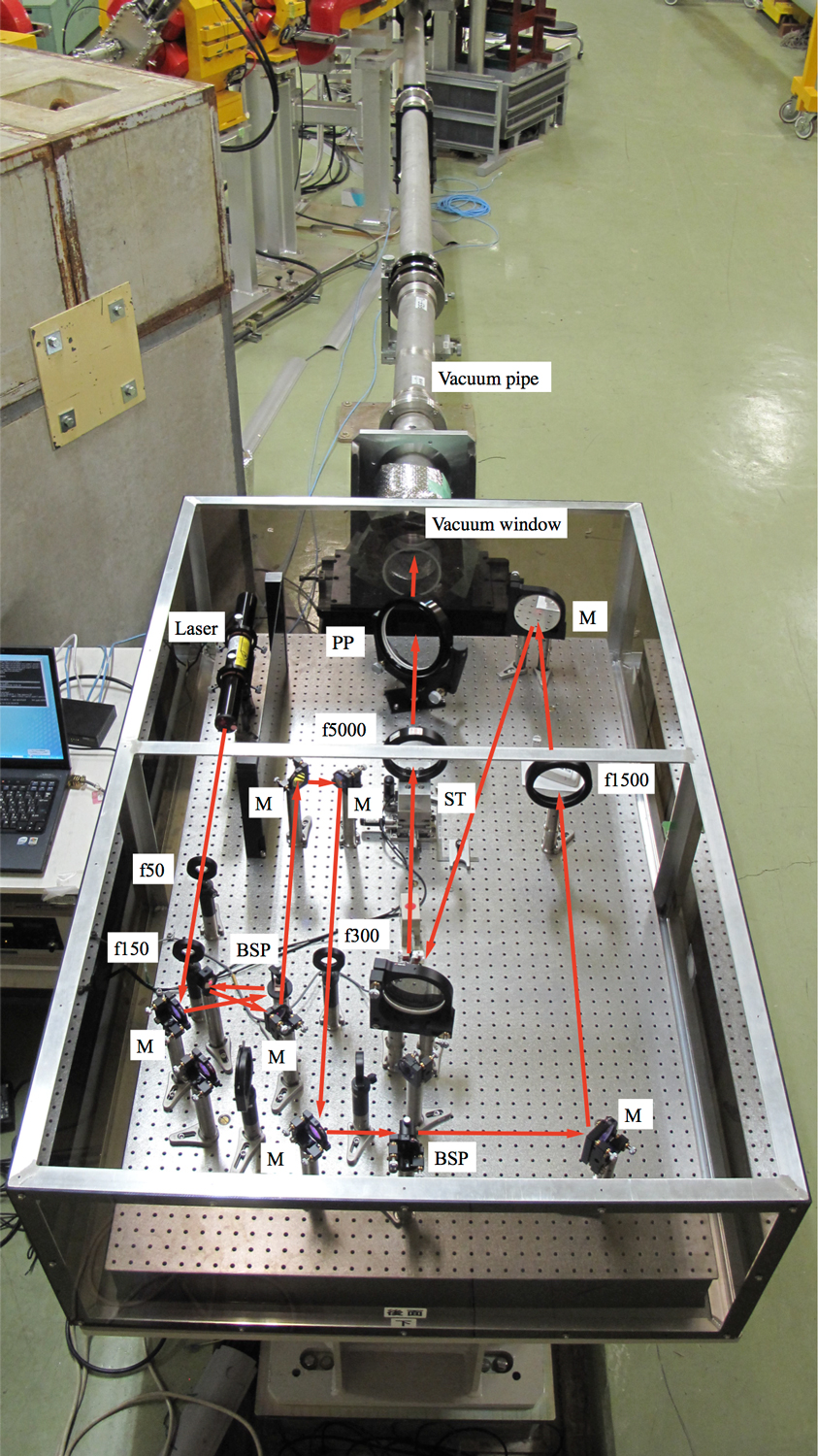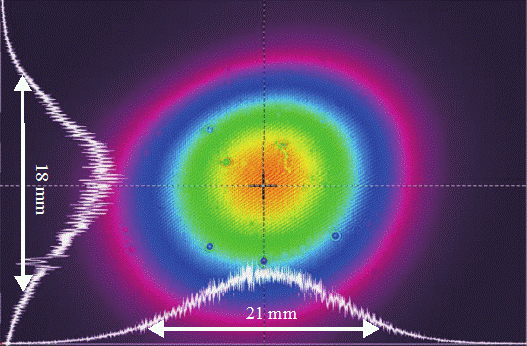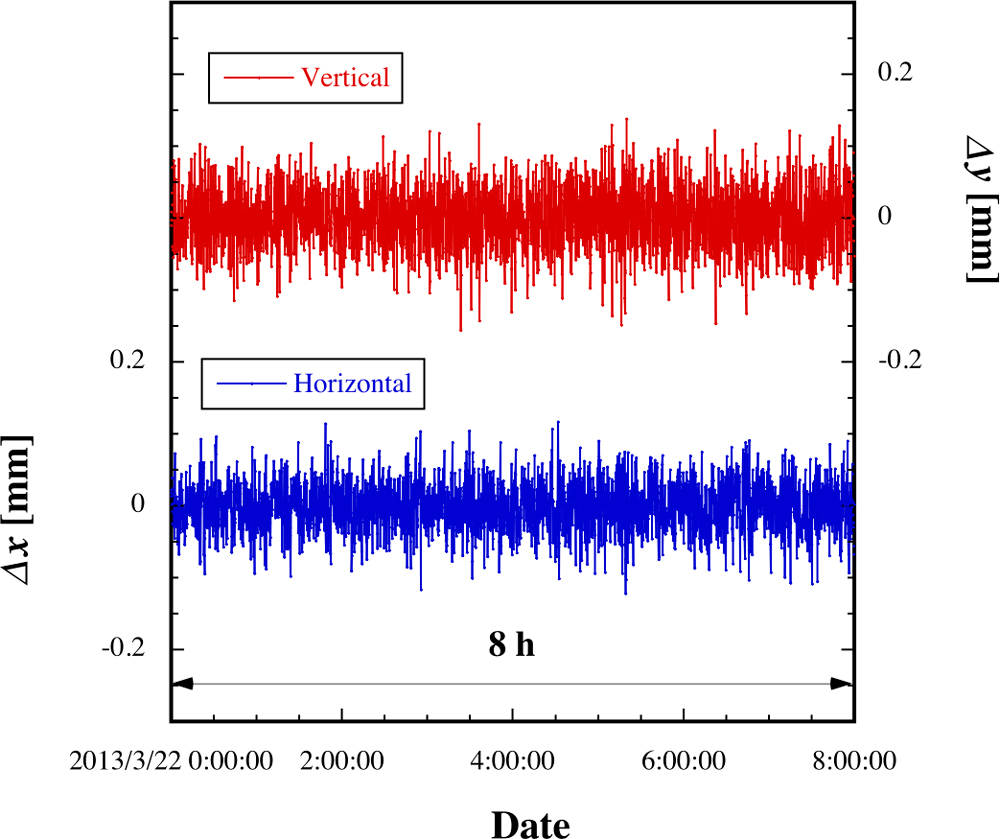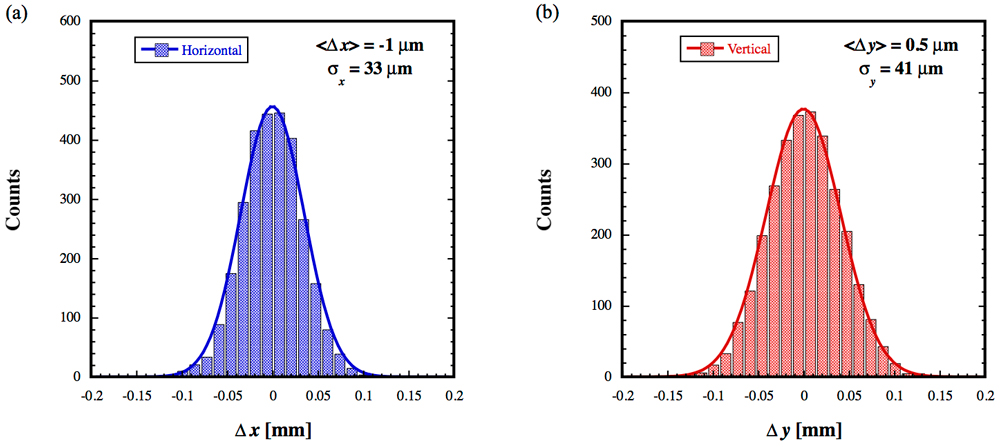Press Release
Successful development of a 500-m-long laser-based fiducial line for high precision alignment of long-distance linear accelerators
October 25, 2013
High Energy Accelerator Research Organization, KEK
Important Achievements- ・Using a simple laser-based alignment system made from commercially available components, a high precision alignment system to locate accelerator units along a 500-m-long fiducial line has been developed for the first time.
- ・This high-precision alignment system enables the stable injection of electron and positron beams that is required for upgrading the KEKB accelerator.
- ・Highly anticipated applications of this system include not only future long-distance linear accelerators, but also large scale civil engineering projects including the construction of dams, tunnels, and levees, where a high precision long-distance alignment is required.
Abstract
A research group led by Tsuyoshi Suwada, an associate professor at the High Energy Accelerator Research Organization (KEK), and Souichi Telada, a head researcher at the National Institute of Advanced Industrial Science and Technology (AIST) of Japan, has succeeded for the first time in developing a laser-based alignment system that allows a high precision alignment of a linear accelerator along a 500-m-long fiducial line.
Currently at KEK, researchers and engineers are seeking to upgrade the KEKB accelerator, a high-intensity electron-positron collider. The KEKB accelerator complex consists of an electron-positron linear accelerator as an injector and storage rings as a collider. For successful experiments using the KEKB accelerator, it is of key importance to accelerate electron and positron beams with the injector and transport them into the storage rings with the highest possible efficiency and stability. To this end, the injector’s large number of accelerator units must be aligned in a 500-m-long straight line with high precision. This only becomes possible by developing a long straight measure (long fiducial line) as a reference to the straight line.
This research group developed a laser optical system that automatically controls the positions of optical lenses with high precision to stabilize the incident angle of a laser beam. This resulted in the successful construction of a laser-based 500-m-long fiducial line with high stability.
This success will not only enable upgrades to the KEKB accelerator, but can also be used for high precision alignment systems in future long-distance linear accelerators. Another exciting area of the application of this system is for large scale civil engineering projects including the construction of dams, tunnels, and levees where a high precision long-distance alignment is required.
Their work was published on September 16, 2013 in the online edition of Review of Scientific Instruments, a scientific journal published in the United States.
Background
As an extremely high performance electron-positron collider, the KEKB accelerator was used to make a key contribution to the confirmation of the Kobayashi-Maskawa theory. This finding was awarded the 2008 Nobel Prize in Physics to Makoto Kobayashi and Toshihide Maskawa.
The KEKB accelerator complex consists of a linear accelerator as an injector and storage rings as a collider. The injector accelerates electrons (electron beam) to 7 GeV and positrons (positron beam) to 4 GeV and transports them into the storage rings where electron and positron beams collide head on to produce B mesons. Currently at KEK, researchers and engineers are seeking to upgrade the KEKB accelerator. These upgrades will improve accelerator performance 40 fold and enable production of sufficient quantities (and subsequent decay) of B mesons that unprecedented levels of precise research on elementary particle physics becomes possible. To achieve such performance, a large number of electrons and positrons must be transported from the injector into the storage rings as stably and efficiently as possible.
The straight portion of the injector (600-m-long total length) extends to 500 m. For the injector to transport electron and positron beams efficiently into the storage rings, stable acceleration and transportation of injection beams are essential. This will be achieved by aligning the many accelerator units that compose the injector in a straight line of high precision. However, owing to the curvature of the earth, such lines are difficult to construct in practice. For example, when accelerator units are placed in a 500-m-long fiducial line on a floor, the end point will be approximately 20 mm below the level of the start point.
Thus far, a telescope-based optical method has been commonly used to perform the alignment; however, it can only align accelerator units up to 10–20 m at a time. To align many accelerator units of a long-distance linear accelerator, the alignment survey must be repeated many times by moving measurement equipment along the accelerator. Unfortunately, there is a measurement error at each survey, which is accumulated during repeated surveys, thereby making the precise alignment of a long-distance accelerator difficult.
To overcome this difficulty, Suwada, Telada, and colleagues used a laser, which travels in a straight line in vacuum, as a long fiducial line. By referring to this long laser-based fiducial line, the many accelerator units of a long-distance linear accelerator can be aligned in a straight line of high precision.
Methods and Results
A laser-based high precision alignment system was first applied by Herrmannsfeldt and colleagues to align the 3-km-long linear accelerator at the SLAC National Accelerator Laboratory (former Stanford Linear Accelerator Center) in the United States in the late 1960s. In their method, a laser beam was injected from one end of the accelerator into specially fabricated Fresnel lenses installed in the accelerator units. The focal length of each lens was adjusted so that the laser beam was focused at the far end of the accelerator. This produced a bright spot at the end of the accelerator that was used as the reference point to align the accelerator. However, this alignment method using specially fabricated Fresnel lenses poses greater difficulty than does the method developed in the present study at KEK.
Suwada, Telada, and colleagues started their collaborative research on long fiducial line laser optics using a He–Ne laser in 2010. This team improved the stability of the laser optics, leading to the successful development of a laser system that allows the high precision alignment of a 500-m-long linear section of the injector at KEK (Fig. 1). To achieve this, they refined the laser optics to allow fine adjustment of the incident angle of the laser beam (Fig. 2), a system that places the entire transportation line of the laser beam in a vacuum, and a control system that automatically stabilizes the incident angle of the laser beam for a long time period. All the apparatus components used in the laser optics and automated control system are commercially available, requiring no special devices.
Using this laser system, the team demonstrated that the incident angle of the laser beam can be stably controlled within a tolerance of ±0.08 μrad (standard deviation). Figure 3 shows the intensity profile of the laser beam measured at the far end of the 500-m-long straight section of the injector. By precisely controlling the positrons of the optical lenses to stabilize the incident angle of the laser beam, they showed that both the horizontal and vertical profiles of the laser beam are extremely stable within a tolerance of ±40 μm (standard deviation) at the far end of the 500-m-long straight line (Figs. 4 and 5).
Significance of This Study and Future Prospect
The present study has established a 500-m-long laser-based fiducial line for the first time and demonstrated that it can be applied to align a long-distance linear accelerator with high precision. It is expected that this alignment system can not only be applied to future long-distance linear accelerators, but also contribute significantly to industry such as large scale civil engineering projects including the construction of dams, tunnels, and levees where a high precision long distance alignment is required.

Fig.1. Schematic layout of the laser-based alignment system. Forty-eight accelerator units in total are distributed along the beam line of the KEK electron/positron injector linac. A quadrant photodiode (QPD) with silicon semiconductor is mounted at the center of both the end surfaces of the accelerator unit. Although the accelerator units are initially distributed along the beam line without any accuracy, they can be precisely aligned with the use of the laser-based fiducial straight line.

Fig.2. Laser source and input optical system; BSP: beam splitter; PP: parallel plate; M: mirror; f: focusing lens; ST: linear stage.

Fig.3. Transverse intensity profile of the laser-based fiducial straight line at the far end of the 500-m-long straight section.

Fig.4. Time traces of the horizontal (x) and vertical (y) position displacements of the laser-based fiducial straight line at the far end of the 500-m-long straight section with the feedback control on during 8 h.

Fig.5. Corresponding (a) horizontal and (b) vertical position displacement distributions at the far end of the 500-m-long straight section in the pointing stability of the laser-based fiducial straight line with the feedback control on.
Review of Scientific Instruments, Vol.84, 093302 (2013) |
Media Contact
Saeko Okada
Senior Press Officer, Public Relations Office, KEK
TEL: +81-29-879-6046
FAX: +81-29-879-6049
E-mail: press@kek.jp